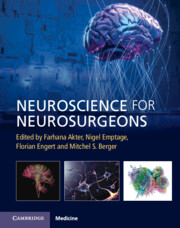Book contents
- Neuroscience for Neurosurgeons
- Neuroscience for Neurosurgeons
- Copyright page
- Contents
- Contributors
- Section 1 Basic and Computational Neuroscience
- Section 2 Clinical Neurosurgical Diseases
- Chapter 12 Glioma
- Chapter 13 Brain Metastases: Molecules to Medicine
- Chapter 14 Benign Adult Brain Tumors and Pediatric Brain Tumors
- Chapter 15 Biomechanics of the Spine
- Chapter 16 Degenerative Cervical Myelopathy
- Chapter 17 Spondylolisthesis
- Chapter 18 Radiculopathy
- Chapter 19 Spinal Tumors
- Chapter 20 Acute Spinal Cord Injury and Spinal Trauma
- Chapter 21 Traumatic Brain Injury
- Chapter 22 Vascular Neurosurgery
- Chapter 23 Pediatric Vascular Malformations
- Chapter 24 Craniofacial Neurosurgery
- Chapter 25 Hydrocephalus
- Chapter 26 Peripheral Nerve Injury Response Mechanisms
- Chapter 27 Clinical Peripheral Nerve Injury Models
- Chapter 28 The Neuroscience of Functional Neurosurgery
- Chapter 29 Neuroradiology: Focused Ultrasound in Neurosurgery
- Chapter 30 Magnetic Resonance Imaging in Neurosurgery
- Chapter 31 Brain Mapping
- Index
- References
Chapter 30 - Magnetic Resonance Imaging in Neurosurgery
from Section 2 - Clinical Neurosurgical Diseases
Published online by Cambridge University Press: 04 January 2024
- Neuroscience for Neurosurgeons
- Neuroscience for Neurosurgeons
- Copyright page
- Contents
- Contributors
- Section 1 Basic and Computational Neuroscience
- Section 2 Clinical Neurosurgical Diseases
- Chapter 12 Glioma
- Chapter 13 Brain Metastases: Molecules to Medicine
- Chapter 14 Benign Adult Brain Tumors and Pediatric Brain Tumors
- Chapter 15 Biomechanics of the Spine
- Chapter 16 Degenerative Cervical Myelopathy
- Chapter 17 Spondylolisthesis
- Chapter 18 Radiculopathy
- Chapter 19 Spinal Tumors
- Chapter 20 Acute Spinal Cord Injury and Spinal Trauma
- Chapter 21 Traumatic Brain Injury
- Chapter 22 Vascular Neurosurgery
- Chapter 23 Pediatric Vascular Malformations
- Chapter 24 Craniofacial Neurosurgery
- Chapter 25 Hydrocephalus
- Chapter 26 Peripheral Nerve Injury Response Mechanisms
- Chapter 27 Clinical Peripheral Nerve Injury Models
- Chapter 28 The Neuroscience of Functional Neurosurgery
- Chapter 29 Neuroradiology: Focused Ultrasound in Neurosurgery
- Chapter 30 Magnetic Resonance Imaging in Neurosurgery
- Chapter 31 Brain Mapping
- Index
- References
Summary
The adoption of magnetic resonance imaging(MRI) into clinical practice brought about a revolution in the diagnosis and treatment of neurological illness, and has dramatically advanced the study of brain anatomy. Early MRI resolved structures in the brain with comparatively poor resolution on the order of 2.5 mm, with limited methods of amplifying contrast between different tissues. Advances in imaging sequences and analytical methods, combined with improvements in spatial resolution and contrast modalities, have dramatically increased the diagnostic and treatment utility of MRI in neurosurgery. Over time, MRI has been used to study and diagnose nervous system diseases of all kinds, from brain tumors, to stroke, to multiple sclerosis. Today, MRI techniques enable the in-vivo study of brain microstructure, connectivity, functional activity, tissue composition, and blood flow; supports surgical planning; and provides critical feedback during selected neurosurgical interventions.
- Type
- Chapter
- Information
- Neuroscience for Neurosurgeons , pp. 398 - 409Publisher: Cambridge University PressPrint publication year: 2024
References
- 1
- Cited by

